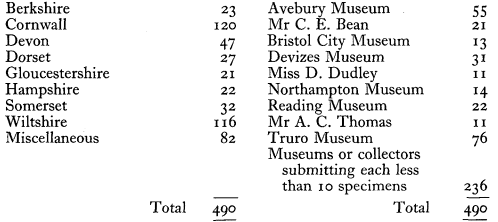Crossref Citations
This article has been cited by the following publications. This list is generated based on data provided by
Crossref.
1964.
Pollen analyses from the deposits of six upland tarns in the Lake District.
Philosophical Transactions of the Royal Society of London. Series B, Biological Sciences,
Vol. 248,
Issue. 746,
p.
205.
Shotton, F.W.
1968.
Prehistoric man's use of stone in Britain.
Proceedings of the Geologists' Association,
Vol. 79,
Issue. 4,
p.
477.
Peacock, D.P.S.
1969.
Neolithic Pottery Production in Cornwall.
Antiquity,
Vol. 43,
Issue. 170,
p.
145.
Roux, C.-T. Le
1971.
A stone axe-factory in Brittany.
Antiquity,
Vol. 45,
Issue. 180,
p.
283.
Hodder, Ian
1974.
Regression analysis of some trade and marketing patterns.
World Archaeology,
Vol. 6,
Issue. 2,
p.
172.
Pitts, Michael W.
Howard, Hilary
Bartlett, Alister
and
David, Andrew
1982.
On the Road to Stonehenge: Report on Investigations beside the A344 in 1968, 1979 and 1980.
Proceedings of the Prehistoric Society,
Vol. 48,
Issue. 1,
p.
75.
Hodder, Ian
and
Lane, Paul
1982.
Contexts for Prehistoric Exchange.
p.
213.
Fenton, M. B.
1984.
The Nature of the Source and the Manufacture of Scottish Battle-axes and Axe-hammers..
Proceedings of the Prehistoric Society,
Vol. 50,
Issue. ,
p.
217.
Chappell, Sylvia
1986.
Alternative Sources in Regional Exchange Systems: A Gravity Model Approach..
Proceedings of the Prehistoric Society,
Vol. 52,
Issue. ,
p.
131.
COONEY, GABRIEL
1989.
STONE AXES OF NORTH LEINSTER.
Oxford Journal of Archaeology,
Vol. 8,
Issue. 2,
p.
145.
Claris, Philip
Quartermaine, James
and
Woolley, A. R.
1989.
The Neolithic Quarries and Axe Factory Sites of Great Langdale and Scafell Pike: A New Field Survey.
Proceedings of the Prehistoric Society,
Vol. 55,
Issue. 1,
p.
1.
Thorpe, Richard S.
Williams-Thorpe, Olwen
Jenkins, D. Graham
Watson, J. S.
Ixer, R. A.
and
Thomas, R. G.
1991.
The Geological Sources and Transport of the Bluestones of Stonehenge, Wiltshire, UK.
Proceedings of the Prehistoric Society,
Vol. 57,
Issue. 2,
p.
103.
Pollard, Joshua
1992.
The Sanctuary, Overton Hill, Wiltshire: A Re-examination.
Proceedings of the Prehistoric Society,
Vol. 58,
Issue. 1,
p.
213.
Sheridan, Alison
Cooney, Gabriel
and
Grogan, Eoin
1992.
Stone Axe Studies in Ireland.
Proceedings of the Prehistoric Society,
Vol. 58,
Issue. 1,
p.
389.
Steedman, Ken
Hall, Allan
Cowgill, Jane
Didsbury, Peter
Drinkall, Gail
Foxon, Andrew
Foreman, Martin
Leahy, Kevin
Makey, Peter
Manby, T.G.
Ottaway, Patrick
Scott, Sally
and
Watt, Jon
1994.
Excavation of a Saxon Site at Riby Cross Roads, Lincolnshire.
Archaeological Journal,
Vol. 151,
Issue. 1,
p.
212.
Cooney, Gabriel
and
Mandal, Stephen
1995.
Getting to the core of the problem: petrological results from the Irish Stone Axe Project.
Antiquity,
Vol. 69,
Issue. 266,
p.
969.
Pollard, Joshua
1995.
Inscribing Space: Formal Deposition at the Later Neolithic Monument of Woodhenge, Wiltshire.
Proceedings of the Prehistoric Society,
Vol. 61,
Issue. ,
p.
137.
MANDAL, S.
1997.
STRIKING THE BALANCE: THE ROLES OF PETROGRAPHY AND GEOCHEMISTRY IN STONE AXE STUDIES IN IRELAND*.
Archaeometry,
Vol. 39,
Issue. 2,
p.
289.
Williams-Thorpe, O.
Webb, P.C.
and
Jones, M.C.
2003.
Non-destructive geochemical and magnetic characterisation of Group XVIII dolerite stone axes and shaft-hole implements from England.
Journal of Archaeological Science,
Vol. 30,
Issue. 10,
p.
1237.
Williams-Thorpe, Olwen
Potts, P.J.
and
Jones, M.C.
2004.
Non-destructive provenancing of bluestone axe-heads in Britain.
Antiquity,
Vol. 78,
Issue. 300,
p.
359.



